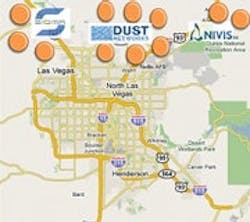Smart Objects Can Communicate Worldwide Using Internet Protocol
By Mike Bacidore, Managing Editor
Interconnected smart objects, the everyday devices around us with embedded sensors providing information to a host application "represent a quantum leap in the way technology will be applied in the coming century," notes Geoff Mulligan, chairman of the IPSO Alliance (www.ipso-alliance.org), an organization promoting a network that will allow sensor-enabled physical objects to talk to one another via an Internet protocol for smart objects (IPSO).
A so-called "smart object" is any device which combines processing power, communications capabilities and a power source to provide real-time information to a computer system. Integration of the Internet protocol, which allows the Internet to run smoothly, in turn allows smart objects to communicate directly with one another over the existing global network following a proven protocol that has been in place for nearly 35 years. The IP framework additionally provides scalability, a vital feature for large organizations.
One particularly notable aspect of this organization's mission is that the technology exists today. The standards do not provide a future plan for what will be accomplished in the next year or decade, but rather what is here now. An organization wishing to deploy this technology can do so immediately, and with confidence that the infrastructure of the network will be around in the foreseeable future.
New member organizations include such familiar names as Intel, Bosch and Johnson Controls, along with more specialized tech and wireless firms CEA, Convergence Wireless, ECE, Ember, IAR Systems, Ibit World, INRIA, Maxfor, National Semiconductor, Somfy, Tridium and ZeroG Wireless rounding out the latest group of companies to join the organization.
IPSO Alliance demonstrated interoperability by linking global sensors to a graphical application display at a recent trade show. More than 100,000 readings from sensors spread throughout Korea, Finland, Sweden, Switzerland, Canada, the U.K. and the U.S. were collected.
Source: IPSO ALLIANCE
These new members bring IPSO's corporate membership to 51, joining companies such as Cisco, Ericsson, SAP, Sun Microsystems and Texas Instruments.
"Intel believes the IPSO Alliance will be an integral group to enable the interoperability and connectivity of devices for the embedded Internet," says Tony Neal-Graves, general manager, strategic planning, embedded and communications group, Intel (www.intel.com). "Intel architecture has played a central role in the build-out of the Internet, and we are committed to delivering products and technology that will enable billions of embedded, connected devices."
A need exists for an open, informal and thought-leading association of like-minded organizations and individuals to promote the value of using the Internet protocol for the networking of smart objects, says Harald Hoenninger, vp corporate research at Bosch (www.bosch.us). "Standards for embedded IP will foster an open-systems approach and achieve high interoperability levels, which are crucial," he says. "As members of the IPSO Alliance, we plan to take a role in the existing and evolving business ecosystems of embedded IT."
This connectivity between physical objects across so many facets represents a quantum leap in the way technology will be applied in the coming century, says Mulligan. "It also explains why so many essential technology companies are joining in our efforts," he says. "The numerous areas of life and platforms that will be impacted is reflected in the caliber of companies partnering with us in these early stages. We expect to see more well-known organizations joining with us in the months ahead."
The introduction of IP sensors and smart objects provide for holistic building operational efficiency by marrying IT systems with HVAC, energy, fire, security and lighting systems, notes Joseph Noworatzky, vice president of engineering for Johnson Controls (www.johnsoncontrols.com). "This convergence of systems creates new synergies and applications for our customers not feasible across independent networks."


